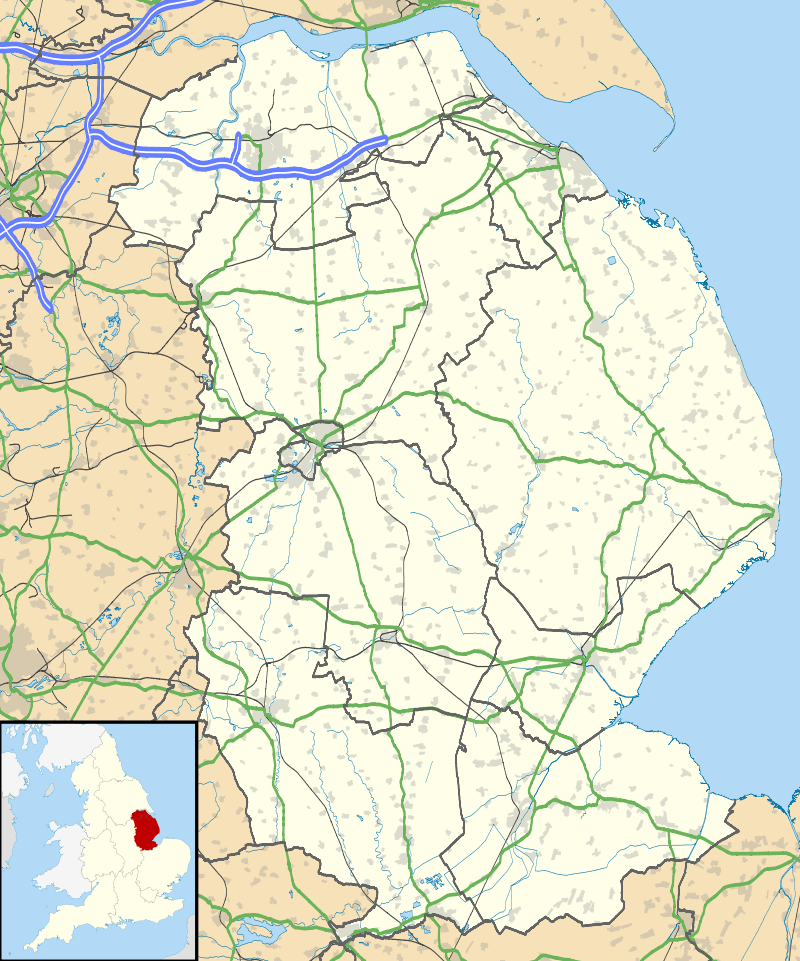Horkstow
| Horkstow | |
 St Maurice Church, Horkstow |
|
 Horkstow |
|
| OS grid reference | TA01982069 |
|---|---|
| – London | 155 mi (249 km) S |
| Unitary authority | North Lincolnshire |
| Ceremonial county | Lincolnshire |
| Region | Yorkshire and the Humber |
| Country | England |
| Sovereign state | United Kingdom |
| Post town | BARTON-UPON-HUMBER |
| Postcode district | DN18 |
| Dialling code | 01652 |
| Police | Humberside |
| Fire | Humberside |
| Ambulance | East Midlands |
| EU Parliament | Yorkshire and the Humber |
| UK Parliament | Brigg and Goole |
|
|
Coordinates: 53°39′04″N 0°30′30″W / 53.651°N 0.5084°W
Horkstow is a village and civil parish in North Lincolnshire, England, 4 miles (6.4 km) south-west from Barton-Upon-Humber, 1 mile (1.6 km) south from South Ferriby and 9 miles (14.5 km) north from Brigg. It lies on the B1204, and 1 mile (1.6 km) east from the navigable River Ancholme.[1] It is one of the five Low Villages - Worlaby, Bonby, Saxby All Saints, Horkstow and South Ferriby - between Brigg and the River Humber, so-called because of their position below the northern edge of the Lincolnshire Wolds.[2] Horkstow was previously part of South Humberside administrative district, and before that, the North Lindsey division of Lindsey, Lincolnshire.[3]
In the Domesday account, the village is referred to as "Horchetou", although the name has gone through various changes since.[4]
Parish church
The parish church, built by The Knights Templar in the early 12th century, is dedicated to St Maurice, and is Grade I listed.[5] It has been much rebuilt and restored since establishment; an internal restoration was carried out in 1868, and an external in 1895.[6] Other places of worship were the Primitive Methodist and Wesleyan chapels, now converted to other use.[1][7]
Listed buildings
Horkstow’s Grade II listed buildings include 17th- and 18th-century barns, and various houses and cottages.[8] Three Horkstow listed buildings, Manor Farmhouse,[9] Horkstow Hall,[10] and Horkstow Grange,[11] are of particular historic note. Charles Gore was born at Horkstow Hall in 1729, he married well and died at Weimar in German high society.[12]
In 1756 artist George Stubbs stayed at Manor Farmhouse to pursue analytical examination and meticulous drawing of horse carcasses acquired from nearby tanneries.[13][14][15]
In 1796 three sections of a tessellated Roman mosaic pavement depicting Greek mythological figures were discovered by workmen in the grounds of Horkstow Hall.[6][16][17][18] The pavement was taken to the British Museum in 1927 on permanent loan, but was transferred to Hull Museum in 1974.[19][20][21]
In 1937 Percy Grainger used the traditional Horkstow Grange folk tune as part of his Lincolnshire Posy suite. Historic folk associations with the Grange inspired the Steeleye Span band name, and their album Horkstow Grange.
Lincolnshire preceptories
Until their disbandment in 1312, the Knights Templar were major landowners on the higher lands of Lincolnshire, where they had a number of preceptories on property which provided income, while Temple Bruer was an estate on the Lincoln Heath, believed to have been used also for military training.[22] The preceptories from which the Lincolnshire properties were managed were:[23]
- Aslackby Preceptory, Kesteven (TF0830)
- Bottesford, Lindsey (SE8907)
- Eagle, Kesteven (SK875672)
- Great Limber, Lindsey (TA1308)
- Horkstow, Lindsey (SE9818)
- Witham Preceptory, Kesteven (SK928205)
- Temple Bruer, Kesteven (TF0054)
- Willoughton Preceptory, Lindsey (SK923931)
- Byard's Leap (SK990494) was part of the Temple Bruer estate.
References
- 1 2 Kelly’s Trade Directory 1900, northlincs.com; retrieved 20 June 2011
- ↑ Horkstow - North Lincolnshire, northlincs.com; retrieved 20 June 2011
- ↑ Horkstow Local History, northlincs.com; retrieved 20 June 2011
- ↑ Horkstow Local History Pack, northlincs.gov.uk; retrieved 7 April 2013
- ↑ Maurice’s Church, churchtrails.com; retrieved 20 June 2011
- 1 2 Cox, J. Charles (1916) Lincolnshire p. 170; Methuen & Co. Ltd
- ↑ Horkstow - Wesleyan Chapel, northlincs.com; retrieved 20 June 2011
- ↑ Horkstow Grade II listed buildings, British Listed Buildings; retrieved 20 June 2011
- ↑ Manor Farmhouse British Listed Buildings; retrieved 20 June 2011
- ↑ Horkstow Hall, British Listed Buildings; retrieved 20 June 2011
- ↑ Horkstow Grange, British Listed Buildings; retrieved 20 June 2011
- ↑ Oliver, R.C.B.: Charles Gore: A Lincolnshire-born High Sheriff of Radnorshire, in: The Transactions of the Radnorshire Society, 1977
- ↑ "Unbridled talent" , The Telegraph 13 June 2005; retrieved 20 June 2011
- ↑ "Lustre, Held by a Groom", Journal of the American Medical Association; retrieved 20 June 2011
- ↑ "Giving Life to the Noble Horse Yale Center Celebrates George Stubbs' Detailed Anatomical Portraits", courant.com; retrieved 20 June 2011
- ↑ Keys, David "Archaeology / Piecing together pagan past", The Independent 1 March 1994; retrieved 20 June 2011
- ↑ The Annual Review and History of Literature edited by A. Aiken, (2010) p. 464, ISBN 1-143-88884-7; retrieved 20 June 2011
- ↑ Lysons, S. The British critic, Volume 21 p. 474, BiblioBazaar (2010) ISBN 1-143-74575-2; retrieved 20 June 2011
- ↑ The British Museum Quarterly, jstor.org; retrieved 20 June 2011
- ↑ "The Horkstow mosaic: a new Roman gallery for Hull museums", Conservation Information Network; retrieved 20 June 2011
- ↑ The Horkstow Mosaic Hull Museums Collection; retrieved 20 June 2011
- ↑ Ward, Penny. Dennis Mills (2nd ed.), ed. The Knights Templar in Kesteven (2 ed.). Heckington: Heritage Lincolnshire Publications. ISBN 978-0-948639-47-0.
- ↑ Page, William, ed. (1906). A History of the County of Lincoln. Victoria County History. 2. pp. 210–213 'Houses of Knights Templars: Willoughton, Eagle, Aslackby, South Witham and Temple Bruer'. Retrieved 12 February 2011.